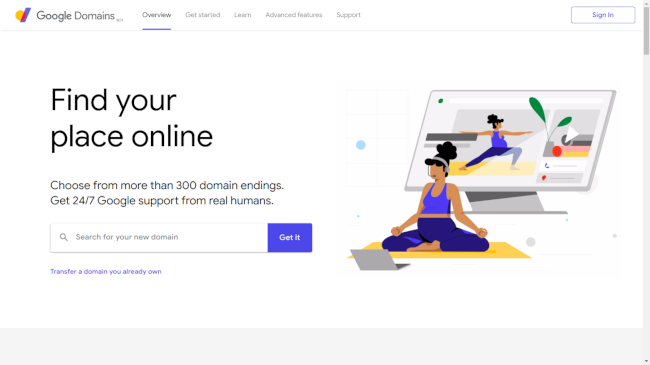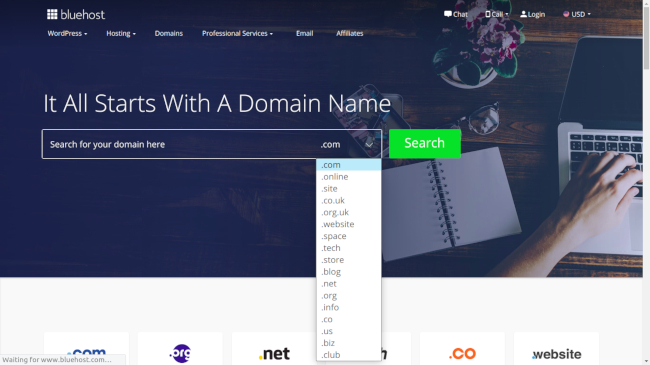How To Create A Blog With Own Domain Name
What is a domain name and why you need to buy one
Everything you want to know about owning real estate on the Internet.

(Image: © Pixabay)
Put simply, a domain name is the mechanism that helps identify and locate computers and resources connected to the Internet and while there are free domain names, you usually have to purchase them through domain registrars.
One of the most essential features of a domain name is that it is unique, which is to say that no two computers (or servers) on the Internet can have the same domain name.
If you want a presence on the Internet you need to register a domain name that will then serve as your unique online name. Visitors will interact with you using this domain name either via your website or via email.
Difference between domain name and URL
Usually the two terms, domain name and URL are used interchangeably. Technically speaking however the two aren't the same.
As mentioned earlier, a domain name is used for identifying computers on the Internet. These computers though use IP addresses, which are a series of numbers, such as 185.113.25.55. Since humans find it easier to remember a string of characters rather than numbers, the pioneers of the web devised domain names to identify entities on the Internet rather than IP addresses.
On the other hand, a URL or a uniform resource locator is made up of the domain name as well as some other pieces of information, including the protocol and the path. For example, https://techradar.com/pro is a URL in which techradar.com is the domain name, while https is the transfer protocol and /pro is the path to a specific section on the website.
In most modern browsers, you don't need to enter the complete URL to visit a website. Simply enter the domain name and the browser will add the protocol and other pieces of information required to bring up the website.

How do domain names work?
When you enter a domain name in the browser, it will send a request to a domain name system (DNS) server. This can either be hosted by your ISP or by a reputable third-party that relies on a distributed global network of servers for superior performance.
It is the duty of these servers to look up the name servers associated with the domain name and then forward your request to those name servers. The name servers are computers that are managed by the website's web hosting company.
The name servers will in turn forward the request to the computer that hosts the website. This computer is called a web server and is powered by a HTTP server software such as Apache, Nginx, and Tomcat, whose duty it is to fetch the website, which is then sent back and rendered on your web browser.
Types of domain names
A domain name is usually broken up into two or more parts, each of which is separated by a dot, such as techradar.com. The section to the right of the last dot in the domain name is the top-level domain (TLD). These are usually one of the generic TLDs (gTLDs) such as .com, .net, and .org.
Then there are ccTLDs, which are country code top level domains such as .uk and .in. They're meant to be used to identify sites meant for specific regions, such as bbc.co.uk or abc.net.au.
Unlike gTLD, many TLDs are intended for a specific use case. For instance, .edu is meant specifically for educational institutions, while .gov can only be used by Government agencies. You can view a list of all valid TLDs here.

Subdomains and parked domains
Besides the above mentioned classification, domain names are categorized in another fashion.
One common type of domain you often hear about is a subdomain, which is exactly what it sounds like, a domain within a domain. A subdomain is usually prefixed to the name of the original domain, for instance, blog.puppylinux.com.
Subdomains are useful as they help you effectively host a different website without purchasing an additional domain name. The subdomains are usually employed to host content that is somehow different from the main domain. For instance, Google uses the support.google.com subdomain to provide help and support for all the services offered by the search engine.
Another popular type of domain is a parked domain. This is usually used as an alias for the main domain and redirects requests to the primary domain. Companies usually use parked domains to secure common misspellings of their primary domain name, such as microsft.com or gooogle.com. Many also use parked domains to register the primary domain with other TLDs, for instance yahoo.net.
The origin of the term however refers to domains that you register but don't point towards any website in particular. These days however the practice of parking domains is often employed for domain squatting. Domain name squatting is the act of purchasing a TLD to prevent someone else from registering it, and then to profit by reselling it. Technically the practice isn't illegal, but is usually frowned upon, especially when done with a nefarious intention.
Who is responsible for domains?
The Internet Corporation for Assigned Names and Numbers (ICANN) is a non-profit organization that creates and implements the policies for domain names. ICANN was established in 1998 to ensure the Internet remains usable by everyone.
ICANN gives permission to sell domain names to companies called Domain Name Registrars. These domain name registrars are allowed to make changes to the domain names registry and pay a small fee to ICANN every time they need to register a domain name.

How do you buy domain names?
You can buy domain names from one of the many domain name registrars, such as Bluehost, GoDaddy, HostGator, and several others. The registrars usually charge for the domain name in 1 year increments, though some allow you to pay upfront for up to 10 years at the time of registration.
In addition to a domain name you'll also need a website hosting account as well. In fact, you almost always approach one of the many hosting companies, which in addition to selling you a hosting plan also offer domain registration services. This arrangement allows you to manage both services under one account.
While the exact process of buying a domain name varies, you usually start by searching if your desired domain name is available. Almost every domain name registrar has a dedicated tool for this purpose. Some of the good ones will go one step ahead and give you suggestions for other potential domain names, if the one you were looking for has already been taken.
You'll then have to pay for the domain name and the price depends on the TLD, with some being more expensive than others. Again, the good domain name registrars will give you the option to buy and park the domain name with different TLDs, and perhaps even offer a discount if you choose to do so. Once the domain name is paid for and registered you'll be able to use it to host your website.
- We've featured the best website builder software.

With almost two decades of writing and reporting on Linux, Mayank Sharma would like everyone to think he's TechRadar Pro's expert on the topic. Of course, he's just as interested in other computing topics, particularly cybersecurity, cloud, containers, and coding.
How To Create A Blog With Own Domain Name
Source: https://www.techradar.com/how-to/what-is-a-domain-name
Posted by: mcclainrisfy1972.blogspot.com

0 Response to "How To Create A Blog With Own Domain Name"
Post a Comment